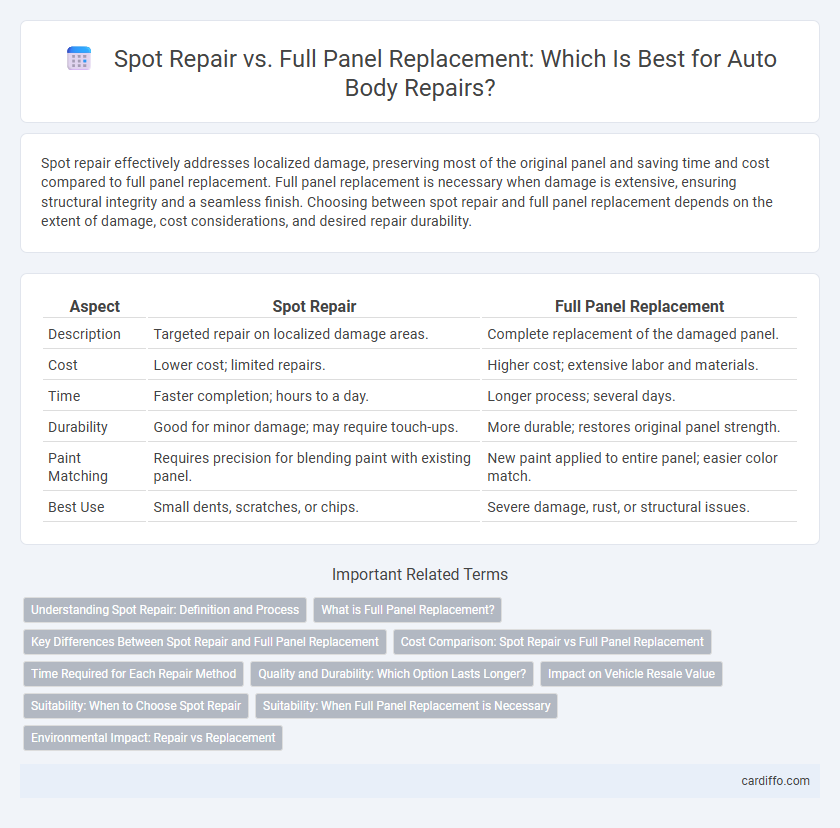Spot repair effectively addresses localized damage, preserving most of the original panel and saving time and cost compared to full panel replacement. Full panel replacement is necessary when damage is extensive, ensuring structural integrity and a seamless finish. Choosing between spot repair and full panel replacement depends on the extent of damage, cost considerations, and desired repair durability.
Table of Comparison
| Aspect | Spot Repair | Full Panel Replacement |
|---|---|---|
| Description | Targeted repair on localized damage areas. | Complete replacement of the damaged panel. |
| Cost | Lower cost; limited repairs. | Higher cost; extensive labor and materials. |
| Time | Faster completion; hours to a day. | Longer process; several days. |
| Durability | Good for minor damage; may require touch-ups. | More durable; restores original panel strength. |
| Paint Matching | Requires precision for blending paint with existing panel. | New paint applied to entire panel; easier color match. |
| Best Use | Small dents, scratches, or chips. | Severe damage, rust, or structural issues. |
Understanding Spot Repair: Definition and Process
Spot repair involves fixing localized damage on a vehicle without replacing the entire panel, making it a cost-effective and time-efficient solution for minor dents, scratches, or paint chips. The process includes cleaning the area, sanding down the damaged spot, applying filler if necessary, priming, and blending the new paint to match the surrounding surface for a seamless finish. This technique preserves most of the original panel's integrity while addressing specific imperfections quickly.
What is Full Panel Replacement?
Full Panel Replacement involves removing and replacing an entire damaged vehicle panel instead of repairing specific dents or scratches. This method ensures structural integrity and a uniform finish, particularly when damage is extensive or metal is weakened. Opting for full panel replacement is often necessary for severe collisions to restore safety and aesthetics accurately.
Key Differences Between Spot Repair and Full Panel Replacement
Spot repair targets localized damage, preserving the surrounding paint and metal, which reduces repair time and costs. Full panel replacement involves removing and installing an entire vehicle panel, ensuring structural integrity and uniform finish for extensive damage. Choosing between these methods depends on damage severity, repair quality, and long-term durability requirements.
Cost Comparison: Spot Repair vs Full Panel Replacement
Spot repair typically costs significantly less than a full panel replacement, with prices often ranging between $50 to $150 depending on the size and location of the damage. Full panel replacement expenses can escalate to $500 or more due to labor, materials, and repainting involved in removing and installing an entire panel. Choosing spot repair for minor dents or scratches offers a cost-effective solution by targeting only the damaged area without the extensive work required for full panel replacement.
Time Required for Each Repair Method
Spot repair typically requires less time than full panel replacement, often taking only a few hours depending on the size of the damage. Full panel replacement involves removing the damaged panel, aligning, welding or fastening the new panel, and refinishing, which can take a full day or more. Choosing spot repair minimizes downtime while full panel replacement ensures structural integrity when damage is extensive.
Quality and Durability: Which Option Lasts Longer?
Spot repair targets only the damaged area, preserving most of the original panel, which can result in a seamless finish if done correctly, but may lack the same long-term durability as a full panel replacement. Full panel replacement involves removing the entire damaged section and installing a new panel, providing maximum structural integrity and resistance to future corrosion or damage. For lasting quality, full panel replacements typically outperform spot repairs, especially in areas prone to rust and prolonged wear.
Impact on Vehicle Resale Value
Spot repair preserves more of the original vehicle panel, maintaining higher resale value by retaining factory paint and metal integrity. Full panel replacement may lower resale value due to potential discrepancies in color matching and structural differences from the replacement part. Insurance companies and buyers often prefer spot repairs for their minimal impact on the vehicle's authenticity and long-term appearance.
Suitability: When to Choose Spot Repair
Spot repair is ideal for minor dents, scratches, or localized damage that does not compromise the structural integrity of the panel. This method suits vehicles with small blemishes where color matching and blending can be effectively achieved without the need for extensive labor. Choosing spot repair saves time and cost while maintaining the original factory finish on undamaged areas.
Suitability: When Full Panel Replacement is Necessary
Full panel replacement is necessary when a vehicle's structural integrity is compromised, such as in cases of severe rust, extensive corrosion, or major collision damage affecting the entire panel. Spot repair is insufficient for large areas with widespread metal fatigue, deep dents, or multiple overlapping damages that cannot be effectively restored to factory standards. Auto body shops recommend full panel replacement to ensure optimal safety, durability, and factory-alike finish when localized repairs do not address the extent of the damage.
Environmental Impact: Repair vs Replacement
Spot repair significantly reduces environmental impact by minimizing waste and conserving resources compared to full panel replacement. By addressing only the damaged area, spot repair lowers the demand for new materials and decreases energy consumption associated with manufacturing and transportation. Full panel replacement generates more scrap metal and increases carbon emissions throughout the repair process, making spot repair a more sustainable choice for vehicle maintenance.
Spot Repair vs Full Panel Replacement Infographic

 cardiffo.com
cardiffo.com